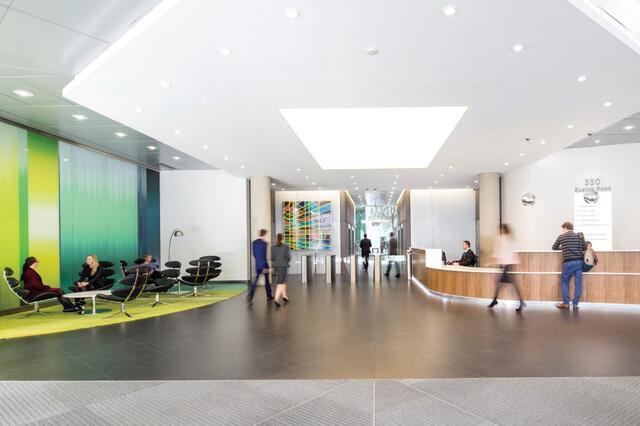Air Source Energy at Regent’s Place
19 May 2015Air Source Energy at Regent’s Place
19 May 2015At 350 Euston Road at Regent’s Place, owner British Land and management team Broadgate Estates Ltd have reduced energy use for common areas and shared services by 65% in six years. Alongside no-cost and low-cost efficiency initiatives, a new air source heat pump is delivering additional cost savings for occupiers and CO2 reductions, whilst maintaining thermal comfort levels in the building. Here, we focus on this technology.
Key Facts
- £51,000 operational cost savings
- Payback within a year
- 81.5% reduction in gas use
- 46.8% primary energy reduction
- 218 tonnes less CO2 in the first year
- 32% Electric energy reduction
Situation
British Land is one of the UK’s leading property firms. The company’s award winning energy reduction programme generates cost savings for occupiers and protects asset value for investors. 350 Euston Road is a seven-storey building, offering over 130,000 sq ft of grade A office space occupied by firms including Balfour Beatty, Capital One, Digital Cinema Media, ELEXON, the General Medical Council and Nimrodental.
When the traditional boiler and chiller system at 350 Euston Road was due for replacement, British Land and Broadgate Estates Ltd partnered with Climaveneta, a manufacturer of central climate control systems, to identify the most efficient solution, and worked closely with Cavendish Engineers to integrate it into the building. The old central heating, ventilation and air conditioning (HVAC) system comprised three boilers, two air-cooled chillers and two air handling units (AHUs) without heat recovery, as well as on-floor fan coil units.
Together, British Land, Broadgate Estates Ltd and Climaveneta developed a comprehensive energy model to simulate how the building operates, so they could test different options and select the most appropriate solution for the building. Two main options were evaluated:
- Option 1: replacing the existing units with upgraded high-efficiency boilers and chillers:
- Option 2: installing a system based on air source heat pumps that transfers heat from outside to inside the building and vice versa
Option 2, with the air source heat pump, offered the best efficiency and greatest lifetime savings for occupiers.
Benefits
In the first six months since installation, reductions compared to the same period the previous year include:
- £51,000 operational cost savings
- 81.5% less gas use
- 46.8% primary energy reduction
- 32% less electrical energy use
- 218 tonnes less CO2 in the first year
The selected heat pump (Climaveneta Integra) can also produce a combination of hot and chilled water, replacing the need for separate boiler and chiller units. This has saved space on the roof, now available to occupiers for additional plant requirements.
Financials
Option 1: upgraded high-efficiency boilers and chillers:
- Investment: £575,000
- Forecast annual energy cost savings: £10,000.
Option 2: system based on air source heat pumps:
- Annual energy cost savings: £51,000
- Payback period on additional investment versus option 1: within 3 months.
Payback was based on conservative estimates, with cost savings assuming the same average annual energy price increases for the coming years as the past ten years, even though energy costs are widely expected to rise by more. The team also included all associated costs in the calculations, such as changes to the distribution system required to make the switch to the new equipment.
Challenges and Achievements
INTEGRATION
How to incorporate new technology into an existing building?
When planning for the plant replacement, the team built a good understanding of occupier requirements in each area of the building at different points in the day, to ensure that the new equipment would deliver on these. Cavendish Engineers also provided the right technical involvement to integrate the new air source heat pump into the existing building management system to operate the building in the most efficient way.
FUNDING
How to get agreement on funding?
The existing chiller and boiler system could potentially have operated for up to four more years. British Land and Broadgate Estates engaged with occupiers on the cost/benefits of earlier replacement, supported by robust savings data. Alongside occupier investment, British Land also agreed to forward-fund 50% of the initial capital investment costs.
INSTALLATION
The practicalities of installing enormous pieces of equipment
The installation of the new air source heat pump was originally scheduled for September 2014. However, it was delayed by over a month due to issues getting permission for road access for the crane to remove the old equipment and install the new. This delay meant that some gas savings on boiler use at the start of the colder period were missed.
Find out more
Matthew Webster
Sustainability and Wellbeing Executive
www.britishland.com/sustainability
*Please note that the information on this page was supplied by the BBP Member and the BBP assumes no responsibility or liability for any errors or omissions in the content

